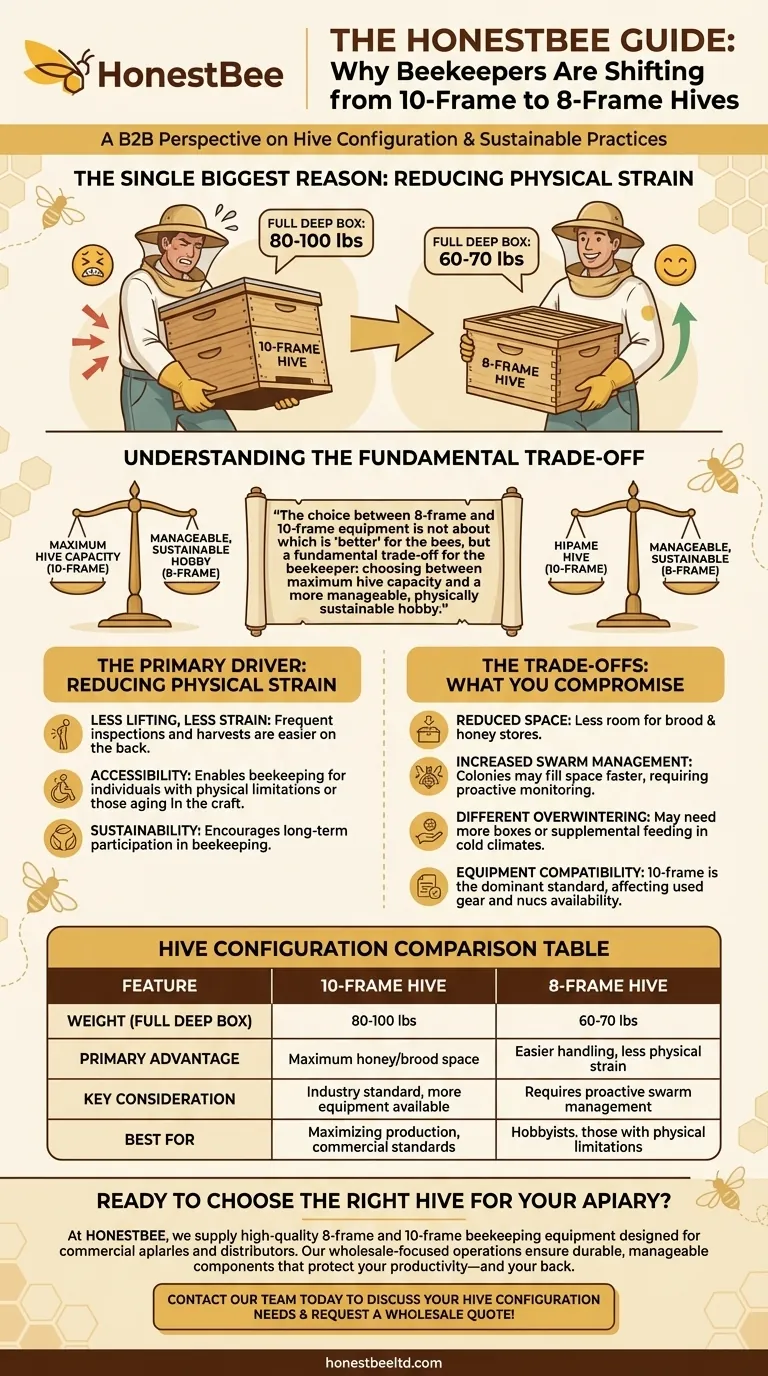The single biggest reason beekeepers are moving from 10-frame to 8-frame hives is to significantly reduce the weight of the equipment they must lift. A full 10-frame deep hive box can weigh 80-100 pounds, while its 8-frame counterpart is lighter, making hive inspections and honey harvesting far more manageable.
The choice between 8-frame and 10-frame equipment is not about which is "better" for the bees, but a fundamental trade-off for the beekeeper: choosing between maximum hive capacity and a more manageable, physically sustainable hobby.

The Primary Driver: Reducing Physical Strain
For decades, the 10-frame Langstroth hive has been the industry standard. However, its significant weight is leading many, especially in the hobbyist community, to seek a lighter alternative.
The Reality of Hive Weight
A standard deep 10-frame box, when full of brood, pollen, and honey, can easily reach 80 pounds or more. A medium honey super isn't much lighter, often weighing around 60 pounds.
Switching to 8-frame equipment reduces this weight considerably. An 8-frame deep box typically maxes out around 60-70 pounds, a difference that is immediately noticeable and deeply appreciated over the course of a full hive inspection.
Why Weight Matters
Beekeeping isn't a one-time lift. During a season, you will lift each of these heavy boxes multiple times for inspections, treatments, and honey harvesting. This repetitive, heavy lifting is a major source of back strain and can become a barrier to enjoying the craft.
Accessibility for More Beekeepers
The lighter weight of 8-frame hives makes beekeeping more accessible. It allows people with back problems, limited physical strength, or those who simply wish to avoid injury to participate fully and continue beekeeping well into their later years.
Understanding the Trade-offs
Choosing an 8-frame hive is not without its compromises. The decision impacts hive management, space, and equipment compatibility.
Reduced Brood and Honey Space
The most obvious trade-off is less space. With two fewer frames per box, the colony has less room for the queen to lay eggs and for workers to store honey and pollen.
Potentially Increased Swarm Management
Because the brood nest is more compact, a strong colony can fill an 8-frame box more quickly. This can lead to the bees feeling crowded sooner, which may increase their natural impulse to swarm if the beekeeper doesn't add more space (supers) proactively.
Different Overwintering Configuration
In colder climates, a colony in a standard two-box 10-frame hive may have enough honey stores for winter. An 8-frame hive holds less honey per box, so a beekeeper might need to use three boxes or provide supplemental feeding to ensure the colony has enough resources to survive.
Equipment Incompatibility
The 10-frame hive is the dominant standard in many regions. This means it can be easier to find used equipment, buy new bees (nucs) that fit your boxes, or exchange frames with a fellow beekeeper if you use the 10-frame size.
Making the Right Choice for Your Goal
Your personal goals and physical ability are the most important factors in this decision. A healthy colony will thrive in either configuration with proper management.
- If your primary focus is physical comfort and ease of management: The 8-frame hive is an excellent choice that makes the hobby more sustainable and enjoyable.
- If your primary focus is maximizing honey production or adhering to commercial standards: The 10-frame hive remains the default, offering the most space per box.
- If you are a new beekeeper and unsure: Prioritizing a positive, manageable first experience is key. Starting with 8-frame equipment is often a wise decision to prevent the physical demands from overshadowing the joy of learning.
Ultimately, choosing the hive that you can manage comfortably and consistently is the best decision for you and your bees.
Summary Table:
| Feature | 10-Frame Hive | 8-Frame Hive |
|---|---|---|
| Weight (Full Deep Box) | 80-100 lbs | 60-70 lbs |
| Primary Advantage | Maximum honey/brood space | Easier handling, less physical strain |
| Key Consideration | Industry standard, more equipment available | Requires proactive swarm management |
| Best For | Maximizing production, commercial standards | Hobbyists, those with physical limitations |
Ready to choose the right hive for your apiary? At HONESTBEE, we supply high-quality 8-frame and 10-frame beekeeping equipment designed for commercial apiaries and distributors. Our wholesale-focused operations ensure you get durable, manageable hive components that protect your productivity—and your back. Contact our team today to discuss your hive configuration needs and request a wholesale quote!
Visual Guide

Related Products
- Langstroth Bee Hives Bee Keeping Box for Beginners Beekeeping
- Long Langstroth Style Horizontal Top Bar Hive for Wholesale
- HONESTBEE Professional Multi-Functional Hive Tool with Ergonomic Wood Handle
- HONESTBEE Advanced Ergonomic Stainless Steel Hive Tool for Beekeeping
- Professional 3-Bar Frame Grip with Integrated Hive Tool
People Also Ask
- Why are Langstroth hives recommended for beginners? Unmatched Support & Standardization
- How does the orientation of the hive sides benefit comb construction? Ensure Straight, Movable Combs for Easier Hive Management
- What are the key features of the Langstroth beehive? A Guide to the Standard for Modern Beekeeping
- What are the different types of beehive boxes available? Choose the Right Hive for Your Apiary
- Why were wooden hives traditionally preferred? For Natural Beekeeping Aligned with Bee Biology



















